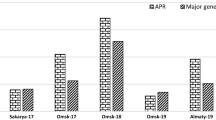Abstract
Resistance to foliar diseases has been studied in 14 promising lines of soft spring wheat developed at the Chelyabinsk Research Institute of Agriculture (CRIA) using donors carrying alien genetic material. Resistance to such diseases as the leaf and stem rust, leaf blotch, and tan spot was assessed in 2019 at the CRIA infection nursery starting from the first manifestations of disease symptoms. Additionally, the juvenile resistance of these lines has been studied at the seedling stage under laboratory conditions. Leaf (Lr) and stem (Sr) rust resistance genes have been identified using molecular markers. Under field conditions, a high level of group resistance to rust and blotch diseases has been observed in the Erythrospermum (Er.) 26620, Lutescens (Lut.) 26708, Ferrugineum (Ferr.) 26768, and Er. 26762 lines. The Lut. 26708 and Ferr. 26768 lines also demonstrate resistance at the seedling stage. The majority (79%) of the studied lines are resistant to leaf and stem rust at both juvenile and adult stages. Molecular marker analysis has revealed these lines carry highly efficient LrSp and Lr24/Sr24 genes occurring either separately or together with low-efficient Lr1, Lr3, and Lr10 genes; the lines are also characterized by effective combinations of Lr9 + Lr26/Sr31 and Lr21 + Lr34/Sr57 genes. The studied wheat lines have a complex of valuable traits, such as lodging resistance, high grain quality, and high yield. Based on the totality of valuable traits and a group resistance to pathogens, the Fer. 26768 line carrying the Lr34/Sr57 + Lr21 + Lr10 gene combination, which has not been previously used for the wheat breeding in Russia, has been selected for use in breeding programs.
Similar content being viewed by others
REFERENCES
Tyunin, V.A. and Shreider, E.R., Osobennosti tekhnologii selektsii myagkoi yarovoi pshenitsy na ustoichivost' k uglevodno-belkovomu istoshcheniyu semyan i drugim stressam v usloviyakh Yuzhnogo Urala (Features of the Technology of Breeding Soft Spring Wheat for Resistance to Carbohydrate-Protein Depletion of Seeds and Other Stresses in the Conditions of the South Urals), Chelyabinsk: Chelyab. Nauchno-Issled. Inst. Sel’sk. Khoz., 2010.
Tyunin, V.A., Shreider, E.R., Gul’tyaeva, E.I., et al., Characterization of the virulence of the Puccinia triticina populations and the prospects of using genes Lr24, Lr25, and LrSp in the selection of spring bread wheat in the Southern Urals, Vavilovskii Zh. Genet. Sel., 2017, vol. 21, no. 5, pp. 523–529. https://doi.org/10.18699/VJ17.269
Meshkova, L.V., Rosseeva, L.P., Shreider, E.R., et al., Virulence of pathotypes of wheat leaf rust pathogen to TH LR 9 in the regions of Siberia and the Urals, Vtoraya Vserossiiskaya konferentsiya. Sovremennye problemy immuniteta rastenii k vrednym organizmam (The Second All-Russian Conference. Current Problems of Plant Immunity to Harmful Organisms), St. Petersburg: VIZR, 2008, pp. 70–73.
Gul'tyaeva, E.I., Shreider, E.R., Shaidayuk, E.L., et al., Monitoring of virulence and phenotypic composition of the Puccinia triticina population in the South Urals in 2018, Vestn. Zashch. Rast., 2019, no. 2, pp. 28–33.
Gosudarstvennyi reestr selektsionnykh dostizhenii, dopushchennykh k ispol’zovaniyu. Sorta rastenii (The State Register of Breeding Achievements Approved for Use. Plant Varieties), Moscow: Rosinformagrotekh, 2020, vol. 1.
Odintsova, I.G., Agafonova, N.A., and Boguslavskii, R.L., Introgressive lines of common wheat with resistance to leaf rust transmitted from Aegilops speltoides, in Iskhodnyi material i problemy selektsii pshenitsy i tritikale: Sb. nauch. tr. po prikl. botanike, genetike i selektsii (Source Materials and Problems in Wheat and Triticale Breeding: Collection of Scientific Papers on Applied Botany, Genetics, and Breeding), Leningrad: VIR, 1991, vol. 142, pp. 106–110.
McIntosh, R.A., Dubcovsky, J., Rogers, W.J., et al., Catalogue of gene symbols for wheat: supplement 2018, Annu. Wheat Newsl., 2018, vol. 64, pp. 84–86.
McIntosh, R.A., Wellings, C.R., and Park, R.F., Wheat Rusts. An Atlas of Resistance Genes, Dordrecht: Kluwer Acad. Publ., 1995.
Saari, E.E. and Prescott, J.M., A scale for appraising the foliar intensity of wheat diseases, Plant Dis. Rep., 1975, vol. 59, pp. 377–380.
Lamari, L. and Bernier, C.C., Evaluation of wheat lines and cultivars to tan spot [Pyrenophora tritici-repentis] based on lesion type, Can. J. Plant Pathol., 1989, vol. 11, no. 1, pp. 49–56.
Błaszczyk, L., Kramer, I., Ordon, F., et al., Validity of selected DNA markers for breeding leaf rust resistant wheat, Cereal Res. Commun., 2008, vol. 36, pp. 201–2013. https://doi.org/10.1556/crc.36.2008.2.1
Chelkowski, J., Golka, L., and Stepien, L., Application of STS markers for leaf rust resistance genes in near-isogenic lines of spring wheat cv. Thatcher, J. Appl. Genet., 2003, vol. 44, no. 3, pp. 323–338.
Marais, T.A. and Bekker, A., Eksteen, et al., Attempts to remove gametocidal genes co-transferred to common wheat with rust resistance from Aegilops speltoides, Euphytica, 2010, vol. 171, pp. 71–85. https://doi.org/10.1007/s10681-009-9996-2
Metodika gosudarstvennogo sortoispytaniya sel’skokhozyaistvennykh kul’tur (Methodology for State Variety Testing of Agricultural Crops), no. 2: Zernovye, krupyanye, zernobobovye, kukuruza i kormovye kul’tury (Cereals, Legumes, Corn, and Fodder Crops), Grigor’ev, A.I., Ed., Moscow: Kolos, 1989.
Metodika gosudarstvennogo sortoispytaniya sel’skokhozyaistvennykh kul’tur, tekhnologicheskaya otsenka zernovykh, krupyanykh i zernobobovykh kul’tur (Methodology for State Variety Testing of Agricultural Crops, Technological Assessment of Cereals and Leguminous Crops), Fedin, M.A., Ed., Moscow: Kolos, 1988.
Sibikeev, S.N., Badaeva, E.D., and Gul’tyaeva, E.I., Comparative analysis of Agropyron intermedium (Host) Beauv 6Agi and 6Agi2 chromosomes in bread wheat cultivars and lines with wheat–wheatgrass substitutions, Russ. J. Genet., 2017, vol. 53, no. 3, pp. 298–309. https://doi.org/10.7868/S0016675817030110
Funding
The study was financially supported by the Russian Foundation for Basic Research (project no. 19-016-00052а).
Author information
Authors and Affiliations
Corresponding author
Ethics declarations
Conflict of interests. The authors declare that they have no conflict of interest.
Statement on the welfare of animals. All applicable international, national, and/or institutional guidelines for the care and use of animals were followed.
Additional information
Translated by N. Statsyuk
About this article
Cite this article
Gultyaeva, E.I., Tyunin, V.A., Shreyder, E.R. et al. Breeding of Soft Spring Wheat for Resistance to Foliar Diseases Under Southern Ural Conditions. Russ. Agricult. Sci. 47, 106–112 (2021). https://doi.org/10.3103/S1068367421020075
Received:
Revised:
Accepted:
Published:
Issue Date:
DOI: https://doi.org/10.3103/S1068367421020075



